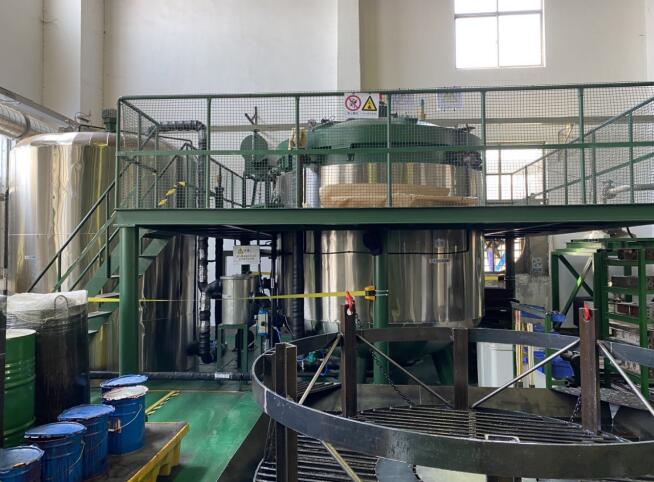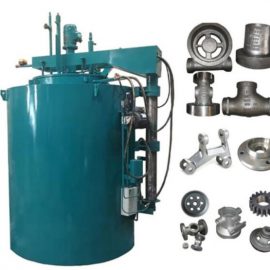Study On Insulation Technology Of Vacuum Pessure Impregnation Paint Between Explosion-Proof Motor And Stator Coil
Abstract: For high-voltage motors, explosion-proof motors, stator coils, and VPI impregnation processes, the actual process parameters of different insulation structures and different technical requirements are also different. Through the analysis of various insulation treatment equipment, it also replaces imports equipment. Increase economic benefits for enterprises.
Keywords: VPI insulation technology, insulation structure, application test
Introduction:
Vacuum pressure impregnation (abbreviation: VPI) insulation process: VPI-vacuum pressure impregnation process is to pre-bake the workpiece to remove moisture, then cool it, and place it in a vacuum environment to remove the air and volatiles inside the white coil, relying on the vacuum paint solution gravity and coil capillary action, and the use of dry compressed air or inert gas to exert a certain pressure on the impregnating varnish after the vacuum is released, so that the varnish quickly penetrates and fills the inner layer of the insulating structure. In China, VPI is currently an insulation process for gap operations. The drip-drying process of the workpiece is carried out in the paint impregnation tank, and the drying process is usually carried out in a separate container or oven, with methods such as vacuum drying, normal pressure static drying or rotary drying.
- Process application of vacuum pressure impregnation equipment:
Comparison: Obviously, VPI is far superior to other impregnation processes in terms of paint penetration and impregnation. In terms of application, VPI is more suitable for large-scale high-voltage coils, multilayer yoke coils, large-scale windings with higher requirements, and other high-voltage coils. Theoretically, the application of VPI, vacuum and pressure can be made quite high, of course, the cost is also high, in the application test and actual work, we found that the vacuum environment for a kind of impregnating varnish under certain temperature conditions, when when the vacuum is lower than a certain absolute pressure value, that is, when a corresponding “critical” vacuum is reached, a large amount of foam and a large amount of mist in the liquid surface of the impregnating paint solution will be generated, that is, “foaming” and “foaming” will occur. Atomization” phenomenon. The “foaming” causes a large number of cavities in the paint, which will hinder the infiltration. “Atomization” causes a large amount of solvent or thinner to escape, which will affect the curing. In principle, the pressure is to make the paint easier to enter the filling gap. The paint process actually has an atmospheric pressure. If the wettability of the capillary in the insulating structure has been balanced, increasing the pressure has no obvious effect on the filling of the entire insulating structure, unless the increased pressure is maintained during curing. Therefore, the effective way to increase the filling is to reduce the viscosity and Reduce the gap of the insulating structure and improve the capillary effect instead of increasing the pressure. According to the test of “Viscosity and Pressure vs. Penetration Rate”, the data shows that when the viscosity of the paint is large, increasing the pressure has a greater effect on the filling speed. When the viscosity of the paint is small, increasing the pressure has no effect on the filling speed. Significantly. However, the viscosity of the paint solution has a very significant effect on the filling speed. The two are in an inverse relationship. It can be seen that in the application of the VPI process, it is blind and useless to emphasize and simply pursue high vacuum or high pressure. As a result, the impregnation efficiency will be affected, and even the impregnation quality will be destroyed.
- Process insulation structure of impregnation equipment
A process has different insulation structures and different technical requirements, and its actual process parameters are also different. For example, VPI has four process parameters, namely vacuum Vi, pressure Pi, temperature Ti, and time ti, where i is 1, 2, 3,…, n (n is the total number of VP process steps, and i is the order of the steps). Insulation structure (W), technical indicators (A), and varnish liquid characteristics (E) are the basic function elements of these four process parameters. The varnish insulation treatment process of motor and transformer windings: from immersion, that is, ordinary immersion to multiple immersion, Then to paint dripping, roll impregnation and vacuum impregnation, vacuum pressure impregnation developed to continuous process of ordinary immersion, dripping and rolling impregnation, and finally to the integration of vacuum impregnation and drying, forming a series of diverse mechanized continuous operations, applications Modern computer technology and PLC technology automatically control the impregnation process, which is constantly evolving and developing through technological innovation, production demand and social development. It is this kind of promotion that has produced a new generation of vacuum impregnation dryers. Energy-saving and environmentally friendly high-tech products and brand-name products have been used by nearly 1,000 users at home and abroad.
The new generation of vacuum impregnation dryer is to put the workpiece into the impregnation dryer for pre-drying, remove the air and volatiles inside the coil in a vacuum environment, and then rely on the gravity of the paint liquid and the capillary action in the coil under vacuum conditions to vacuum impregnation the paint , It is a kind of mechanical insulation process that makes the paint liquid quickly penetrate and fill the inner layer of the insulation structure.
FGH process flow→put in the workpiece→white blank pre-baking→vacuum dehumidification→vacuum impregnation→returning→dropping→cleaning→cleaning agent→low-temperature drying to high-temperature curing→heat preservation→out of the furnace, fully sealed and no environmental pollution Complete it in one go.
Advantages of FGH: In the scope of application of FGH process, the advantages of its function are mainly in the following aspects.
(1) Improve the integrity. Because the vacuum impregnation paint makes the insulating paint almost completely fill the inside of the insulation, the integrity of the entire winding is strengthened. Each part of the winding will not move separately during operation, which reduces the failure caused by mobile wear.
(2) Improve resistance to environmental conditions. Due to vacuum impregnation, the entire impregnation process, including paint transfer and impregnation drying, is carried out and completed in a completely sealed container. The entire drying process is heated by hot air circulation, and the generated exhaust gas passes through The condensers of the A and B groups are recycled and discharged to improve the working environment and meet environmental protection requirements.
(3) Reduce the operating temperature and temperature rise. Because the vacuum impregnation and drying are integrated and completely filled, the insulating paint replaces the internal air gap well and improves the thermal conductivity. Generally, it can reduce 5-10 ℃ for motors and transformers.
(4) Improve the performance of the workpiece. Due to the vacuum impregnation and drying, the entire winding is tightly sealed and saturated by the impregnation paint, and the surface paint film is smooth and shiny, so that pollutants, moist gases and chemical gases cannot enter the inner layer, eliminating the conductive medium frame Failure caused by the bridge.
(5) Energy saving and cost reduction. Due to the integration of vacuum impregnation and drying, the drying time is two-fifths shorter than that of the oven, and the drying temperature is 10-20°C lower than that of the oven, further realizing increased production, energy saving and cost reduction.
- Vacuum impregnation exhaust gas treatment equipment
KFCJ type activated carbon adsorption purification system is designed according to the exhaust gas temperature, exhaust gas concentration, emission volume, type of exhaust gas and national emission standards provided by the user. The exhaust gas has high concentration, high temperature and low operating cost. Considering adsorption and other comprehensive considerations, the granular activated carbon adsorption recovery device is generally selected as the main equipment. The working principle of the activated carbon bed is divided into two parts, one is adsorption, and the other is desorption regeneration. After the exhaust gas is cooled by a gas cooler, the gas enters the activated carbon box and passes After the internal activated carbon is adsorbed, the harmful components are removed, and the purified gas that meets the emission standards is discharged, and discharged to the outdoor by the fan. The activated carbon has been used for a period of time to adsorb a certain amount of solvent (the length of use depends on the content of the gas and the length of production time). During regeneration, 0.07Mpa steam is sprayed into the adsorption box during regeneration, and the various solvents adsorbed in the activated carbon are evaporated, and then condensed into liquid through the condenser and enters the separation cylinder. The organic solvent is separated and recovered, and the residual liquid enters the aeration cylinder. The high temperature affects the adsorption effect of activated carbon. Therefore, the exhaust gas cooling device is implemented before the adsorption. The temperature is reduced to about 40 degrees. The cooled exhaust gas finally reaches the adsorption tank. The flow velocity of the activated carbon layer is less than 0.70 m/s, so that the adsorption effect of the activated carbon can be guaranteed.
- Conclusion
Due to energy shortages and increasingly serious environmental pollution, the VPI-vacuum pressure impregnation equipment and exhaust gas treatment equipment have reached the national secondary emission standards. The equipment is designed and manufactured by the technical department and is a product of today’s technology and information age. It is a development of the application of vacuum impregnation paint, a supplement to the application technology of exhaust gas treatment of those impregnation paint, and an extension of the application of the process, an advancement.

How to cut solidified annealed nanocrystalline iron core with little effect on magnetic properties Effect of Annealing Temperature on Microstructure and Soft Magnetic Properties of FeGaGeBCu(P) Amorphous Nanocrystalline Alloy Improvement of Carburizing and Quenching Taper Deformation of Driven Gear


Contact us
Your email address will not be published. Required fields are marked *